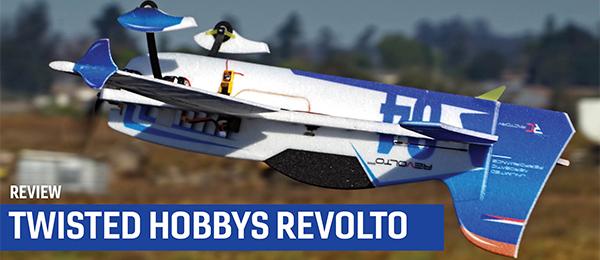Written by Terry Dunn
Tremendous Power That Sacrifices Nothing In Flight Time
As seen in the May 2021 issue of Model Aviation.
Bonus Video
Image


WATCH A VIDEO ONLINE!
Access additional content by visiting www.ModelAviation.com/bonuscontent. THE PIRAÑA, designed by Quique Somenzini, represents a new way of looking at electric power systems. You would normally expect a model of this size to be powered by a three- or four-cell LiPo battery of approximately 2,200 mAh capacity. And why not? You could certainly get good performance from such a power system. Flex Innovations dismissed this traditional formula with the Piraña, using what the company calls 6S Raw Power Series. It is designed to use a six-cell LiPo battery of only 1,500 mAh capacity! Make no assumptions about any negative tradeoffs with this approach. The result is an airplane with tremendous power that sacrifices nothing in flight time.About the Piraña
This flying wing is made of molded foam components. It is available in orange or the yellow scheme shown here. All of the accent stickers are factory applied. My example has a nice mold quality and crisp paint lines. The only blemish I could find was that one of the foam pieces was a slightly different shade of yellow from the rest of the airplane. Most of the electronics that you will need are included with the Piraña. Two Potenza DS12 digital servos actuate the dual rudders, while DS17 digital servos drive the elevons. All of these servos are factory installed and linked to their respective control surfaces with pushrods.Image

Image

Assembling the Piraña
The wing panels are supported by two carbon-fiber spars that attach to the fuselage with self-tapping screws. Integrated plastic supports strengthen the foam where the screws are inserted. Trenches for the elevon and LED wires are molded into the bottom of the wing. The parts assemble quickly and provide a neat, clean appearance. Screws are also used to fasten the twin vertical stabilizers to the top of the wing. Both of the stabilizers have molded pockets that are designed to hold a satellite receiver. I installed the Spektrum 9645 in the starboard stabilizer and it fit perfectly. It’s a clever design. Those who use S.Bus radio gear will find room to mount their receiver inside the fuselage. I encountered two minor issues when mounting the vertical stabilizers. First, the wire-routing slots in the wing and vertical stabilizers did not quite line up on the port side (the starboard side matched perfectly). I used a hobby knife to join the mismatched slots. The other hiccup was that both rudders touched the top of the wing surface, which hindered their movements. I used a hobby knife to carefully trim the bottom edge of both rudders. I left a 1/8-inch gap between the rudders and the top of the wing. The magnetically secured canopy doubles as a hatch that provides access to the Piraña’s innards. The battery sits on top of a plywood tray. A beefy hook-and-loop strap holds the battery in position. Two nose cones are provided. I used the standard "pointy" nose that gives the Piraña a sleek, jet-like appearance. The alternate nose is designed to accept a small camera, for those who like to fly via FPV. Both nose cones are held in place with magnets and clear tape.Setting Up the Piraña
The included manual does an excellent job of explaining the process for configuring your radio system for the Piraña. Make sure that you follow it precisely and be sure to perform all of the control direction tests (with the propeller removed for safety) before you try to fly this airplane. The FT Aura 5 Lite flight controller comes configured with three default flight modes. You can select any of these modes on the fly with a three-position switch on your transmitter. Mode 1 (Sport, Gyro Off) features lowrate control throws and exponential movement. Mode 2 (Sport, Gyro On) is much like Mode 1, but it engages the gyros with low gain. Note that the gyro function in this flight mode does not provide self-leveling abilities. You still have to fly the airplane. The gyros merely serve to smooth the Piraña’s flight path. Mode 3 (Advanced, Gyro On) bumps up the control throws and the gyro gains. This mode opens the wildest, most aerobatic side of the Piraña. You’ll see. The flight controller also offers a few features with which you should become familiar. I strongly urge you to utilize Launch Assist and Air Brakes. Launch Assist is enabled with a simple stick movement on the transmitter. It will hold the nose up and keep the wing level when you launch the airplane. It takes all of the stress out of hand launching. Launch Assist automatically disengages once you begin controlling the Piraña. Air Brakes are enabled with a two-position switch. When active, the twin rudders move inward to dramatically increase drag. Rudder movement with Air Brakes is inversely proportional to the throttle position (full throttle equals no braking; idle throttle equals maximum braking). This is a handy energy-management feature on the Piraña’s otherwise slippery airframe. Level Assist prevents the aircraft from being overcontrolled by limiting pitch and bank angles and prevents the aircraft from rotating upside down. It also self-levels the aircraft when the sticks are returned to neutral. Activating Level Assist replaces Flight Mode 1 in the standard setup.Flying the Piraña
I performed a quick power check before my first flight with the Piraña. During a static test, I measured approximately 35 amps of current and a little more than 800 watts of power! That is a tremendous amount of power for a model of this size and weight. Furthermore, all of the power system components were operating well within their advertised limits.Image

Image

Image

Image

Image











Comments
Add new comment